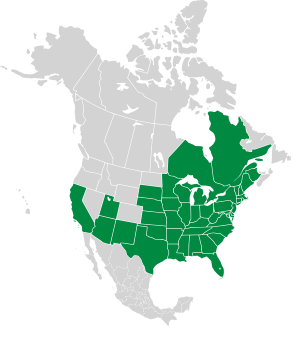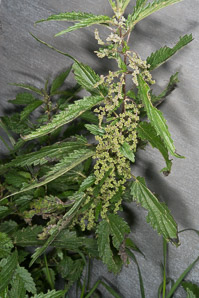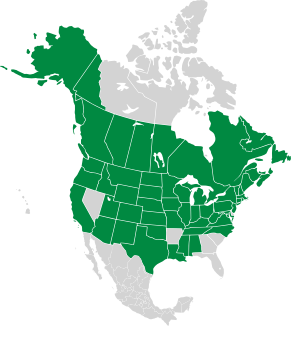|
Urtica dioica L. ssp. gracilis (Aiton) Seland.
Stinging nettle, common nettle
| Kingdom | Plantae | Plants, but not fungi, lichens, or algae |
| Subkingdom | Tracheobionta | Vascular plants—plants with a “circulatory system” for delivering water and nutrients |
| Division | Magnoliophyta | Flowering plants, also known as angiosperms |
| Class | Magnoliopsida | Dicotyledons—plants with two initial seed leaves |
| Subclass | Rosidae | Roses, legumes, proteas, dogwoods, hydrangeas, mistletoes, euphorbias, grapes, many more |
| Order | Urticales | Includes cannabis, nettles, mulberries, elms, others |
| Family | Urticaceae | Nettle family |
| Genus | Urtica | From uro, “I burn,” alluding to the nettle’s sting |
| Species | dioica | Dioecious, having male and female flowers on separate plants |
| ssp. | gracilis | Slender, graceful |
About plant names...
Stinging nettle, so named for spiky hairs that are pretty much tiny hypodermic needles
filled with a witch’s brew of irritating chemicals. You really have to appreciate stinging
nettles. Most irritating plants inject something that causes your body to produce histamine
in defense, which results in itching and burning. Nettles get right to the point: they inject you with
histamine itself, along with serotonin, acetylcholine, formic acid
(the same irritant in some bee stings), and leukotriens. They are specialists in chemical warfare.
These plants are North American natives. (A close relative, Urtica dioica ssp. dioica, is native to Europe and Asia, though long established in
North America.) Both are found in temperate regions worldwide. They prefer
river deltas, floodplains, margins of deciduous woodlands, fencerows, and waste places.
Plants: 2-3′ (60-100 cm) high, rarely up to
twice that. The entire plant
is covered in stinging hairs.
Leaves: Opposite, oblong, cordate,
and serrate (with sawtooth edges). They are 1-6″ (3-15 cm) long.
Flowers: Plants are monoecious—male
staminate flowers appear on the same plants as female
pistillate flowers. Male flowers are grayish yellow, with four tepals.
Female flowers have four tepals too, but in different-sized pairs. They are
gray-green and hairy. The flower clusters resemble catkins.
Fruits: Each inner pair of tepals encloses a single
deltoid to ovoid seed.
Edibility: Dried or cooked, the young leaves are safely
edible, and taste like spinach. Don’t even think about eating them raw!
Medical: Historically stinging nettle has been
used to treat muscle and joint pain, eczema, arthritis, gout, anemia, and many other ailments. More recent
studies have found that plant extracts aid in treatment of urinary tract infections,
kidney and bladder stones, and rheumatism. Root extracts have been used to treat
prostate complaints and irritable bladder. Stinging nettle extracts should not be used
during pregnancy.
|
|

9/1/2013 · Trail Near James River, Midlothian, Virginia · ≈ 5 × 8″ (13 × 19 cm) 
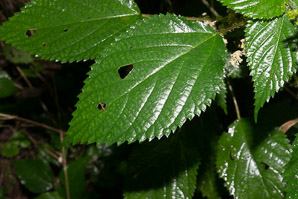
9/1/2013 · Trail Near James River, Midlothian, Virginia · ≈ 9 × 6″ (22 × 15 cm) 

9/1/2013 · Trail Near James River, Midlothian, Virginia · ≈ 7 × 11″ (18 × 28 cm) 
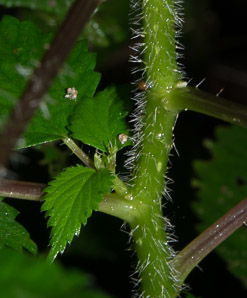
9/1/2013 · Trail Near James River, Midlothian, Virginia · ≈ 6 × 8″ (14 × 20 cm) 
|









